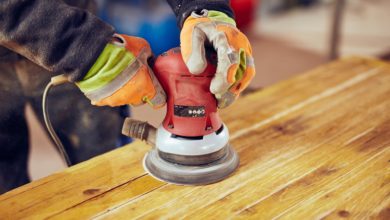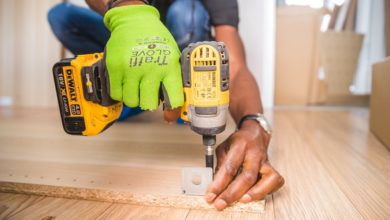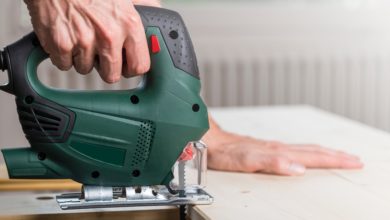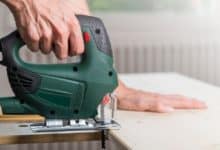 From the casual DIY enthusiast getting started on modest home improvement projects to the professional contractor, everyone can benefit from the nail-driving force of a nail gun.
From the casual DIY enthusiast getting started on modest home improvement projects to the professional contractor, everyone can benefit from the nail-driving force of a nail gun.
This device can save precious time while helping you accomplish much more with much less strain.
It is important to know the features, merits, and demerits of the various available nailers in the market.
This will help you get the best value for your hard-earned bucks when you hit the store.
Here’s a brief survey of some of the more popular models today.
1. DEWALT Brad Nailer Kit
 This nail gun is made to deliver a stress-free nailing experience to DIYers and professionals alike. It is high-performance- driving nails of up to two inches with its sequential trigger. With a capacity of up to a hundred nails in its magazine, users can work with minimal interruption.
This nail gun is made to deliver a stress-free nailing experience to DIYers and professionals alike. It is high-performance- driving nails of up to two inches with its sequential trigger. With a capacity of up to a hundred nails in its magazine, users can work with minimal interruption.
DeWalt has also designed this nailer with the user’s comfort in mind; it has a comfortable rubber grip, which keeps it from slipping during use.
Its lightweight design makes this nailer even easier to handle. To enable you to have a better view of your work, this nailer comes with a small nose tip. Among the other bells and whistles, it comes with are LED lights that indicate a nail jam.
- Drives 18-gauge Brad nails from 5/8 to 2 inches.
- Weight: 2.65 lbs.
- Lightweight magnesium body.
- 765kV pneumatic power source.
Our In-Depth Review:
With this nail gun, you will be able to push in nails of between 5/8 and two inches. The mechanism to do this is powered by a low-maintenance motor.
The adaptability of this nail gun to different functions is one of its key selling points. You can shoot nails individually one by one if you want greater accuracy and tidiness or in a rapid sequence (bump nailing) if you just need to secure board with as many nails as possible.
In the latter mode, you just keep the trigger depressed and bump away. Switching between these two modes is done by simply flicking a well-labeled switch at the base of the gun. Increasing or decreasing the depth of drive is just as simple.
Still, on making the nailer easy to work with, its manufacturers equipped it with LED lights near the base that are easily visible to the user. One of them flashes four times to warn the user when the battery is running out of juice. The other flashes continuously when there is a nail jam.
This nailer doesn’t just take care of the user and itself; it helps you produce tidier work as well. A lockout feature keeps the gun from firing when it’s down to its last few brad nails so that you don’t scar the surface with dry fire.
A detachable belt hook allows users to carry the nail gun on either side of their belt.
Pros
- Very reasonably priced.
- Light and ergonomically designed.
- Nose tip increases accuracy.
- Versatile in terms of speed of dispensing nails.
Cons
- Not suitable for heavy industrial use.
- A bit challenging to use because of its Pneumatic operation.
Conclusion:
The DeWalt Brad Nailer offers great value for money; it is a great tool to have when on a budget. It will come in very handy for various house repair jobs. It has a reasonably solid build quality and it does its job very well. In addition to that, it comes with a slew of extra features that make it very easy to use. Some previous users complain about it getting easily damaged, but if put to moderate use it should serve you well.
2. WEN 61720
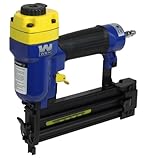 Domestic DIY enthusiasts or homeowners seeking to do their own repairs and enhancements can rely on the WEN 61720 for the efficient, tidy shooting of brads.
Domestic DIY enthusiasts or homeowners seeking to do their own repairs and enhancements can rely on the WEN 61720 for the efficient, tidy shooting of brads.
You can use it to knock in 18-gauge brads of between ¾ and 2 inches. It comes with numerous features that make usage very straightforward.
Its sizeable magazine allows you to stack up to 100 brads to maintain a continuous workflow.
To help keep you from ruining your work surface with dry fire, the magazine has a window that shows the remaining brads. The light, ergonomic design of this nailer also adds to its ease of use. It offers plenty of value to buyers given its very reasonable asking price.
- Works with a 60-100 psi compressor.
- 1/4” air inlet.
- 100-brad capacity magazine.
Our In-Depth Review:
One of the things you will notice immediately about this nailer is how compact it is. The lightweight design of this model makes it easier to work with for longer durations. It also means you can carry it around with far less hustle (the case it comes with makes this even more convenient).
In addition to the light design, this 18-gauge nailer comes with a comfortable rubber grip to make it easy on the hand. You can use it for long durations without suffering wrist strain. Its soft nose makes it easy on the work surface too, improving the quality of the final finish.
The compact design, and indeed the attractive price, of this nailer seems to come at a great sacrifice in terms of its performance. This is not an industrial-grade nailer by any stretch of the imagination. Subject it to a heavy workload and it will wear out quickly. But if all you need is a tool to help you accomplish simple home improvement jobs, this nailer will serve you for some time.
One other demerit this nailer will exhibit over time is degraded performance. While this is something you will expect with just about any machine, the drop in the performance of the WEN 61720’s shooting capability tends to happen sooner than one would like.
Though it is aimed more or less at novice users, the fact that it does not have a tool-free mechanism to release jammed nails seems to defeat the point.
Pros
- Compact, light build means you can use it for longer than other models.
- Comfortably sets nails of between ¾ and two inches.
- Easy to use for novice DIYers.
- Offers good performance for home improvement tasks.
Cons
- Not built for a heavy workload.
- Feels a bit flimsy.
- Jam release is not tool-free.
Conclusion:
The WEN 61720 is a great tool for entry-level DIYers and home improvement enthusiasts to handle occasional jobs. It may be compact and light, but it packs enough punch for this category of a nailer, punching in ¾ to 2-inch brads with minimal fuss. And it comes at a very attractive price point. However, contractors and other professionals may get frustrated with the level of performance this nailer offers when they try to use it for extended periods of time.
3. Stanley TRE550Z
 This electric brad nailer offers great performance for driving nails and staples that rivals that of its Pneumatic competitors.
This electric brad nailer offers great performance for driving nails and staples that rivals that of its Pneumatic competitors.
That is if you are a DIYer putting it to occasional use. Its lightweight, ergonomic design is also clearly made with domestic users in mind. Those who suffer joint pains will be grateful for this as well.
Though it has to be plugged into a direct power source like any other fully electric appliance, it comes with an eight-foot cord for an increased range of motion.
This should suffice to allow domestic users to use the nailer in most any part of the house. And it offers users a degree of versatility with two power levels for hard and softer materials.
- 120v power capacity.
- For use with Stanley Sharpshooter TRA700 staples.
- For use with ½ to 5/8-inch Brad nails.
- Strong 8-foot power cord.
Our In-Depth Review:
An easy-to-use jam release mechanism helps users save time whenever nails get jammed. If you want to adjust the depth to which you can drive the nails you can use the conveniently placed knob at the back of the nailer. Though this nailer has to be connected to an electric power source, the eight-foot power cord it comes with means you can always reach your work area without much strain.
The Stanley TRE550Z is versatile in regards to the array of nails and staples it can be used to fire. It can be used with the Stanley Sharpshooter TRA700 Series or Arrow T-50 staples as well as brad nails of ½, 9/16 and 5/8 inches in length.
Folks who suffer from joint paint will be delighted with how easy this nail gun is on the wrist. Its shape and weight (just over two pounds) are conducive to heavy and moderate driving of nails and staples. And the safety of users and non-users alike is enhanced by the lock mechanism that prevents accidental firing.
If you’re a contractor looking for a nailer or staple gun to see you through jobs requiring heavy usage, the TRE55OZ is not the ideal tool. It will not be able to withstand consistent daily usage for too long.
Pros
- Light and easy on the hands.
- The lengthy power cord improves reach.
- Flat nose for shooting in tight spaces.
- Dual power mode for different kinds of surfaces.
- Safety lock to prevent an accidental shooting.
Cons
- Not built for commercial use.
Conclusion:
This is one of the most affordable nail guns out there. Yet it offers solid value for money to home users looking to do their own improvements. This electric nailer is easy to use for even DIY enthusiasts who are just starting out. The Stanley TRE55OZ is ideal for moderate domestic use and will quickly start showing signs of wear if overworked. You will be pushing it if you try to use it to punch through boards thicker than 2 by 4.
4. Porter-Cable Nailer Kit
 Contractors and other heavy construction tool users will appreciate the Porter-Cable 20V Max Cordless brad nailer for how much it can help them get done. It shoots 18 gauge brads of 5/8 to two inches length powered by a specially designed motor.
Contractors and other heavy construction tool users will appreciate the Porter-Cable 20V Max Cordless brad nailer for how much it can help them get done. It shoots 18 gauge brads of 5/8 to two inches length powered by a specially designed motor.
The motor is in turn powered by a 1.5Ah, 20V rechargeable battery, as opposed to the compressor or gas-powered heavy-duty models. This is enough juice to pump out thousands of brads on a single charge.
Owners will also appreciate this gadget for how easy it is to use. Tool-free jam release and depth adjustment ensures users are able to work fluidly
It is heavy on the hand than other models, including the weight of the battery pack that powers it. But pros will consider this a minor tradeoff bearing in mind this nailer’s level of performance.
- Shoots 18-gauge brad nails.
- 100-brad magazine capacity.
- The tool-free jam release mechanism.
- 20V, 1.5 amp Li-ion battery pack.
Our In-Depth Review:
Cordless nailers like the Porter Cable Max make it a lot easier to navigate around your workspace than if you had to mind a power cord. They also don’t need you to lug around a compressor. The fact that the nailer doesn’t need a lot of power to fire means you most likely won’t need to carry and extra battery. DIYers will like the idea of not having to buy oil as is required with pneumatic versions.
There is a lock conveniently located near the trigger, which you can slide up to keep the gun from firing accidentally. To be extra sure, it is recommended that you slide out the battery pack whenever the nailer is not in use.
Using this gun is fairly easy as it is well balanced and not too weighty as compared to other nailers in its class. However, at almost six pounds, the Porter-Cable 20V Max is heavier than most entry-level nail guns. It does come with a belt hook to ease portability, though.
Pros
- Safety lock-out feature.
- Well designed for heavy use.
- LED lights for multiple functions.
- Don’t need to lug a compressor around.
Cons
- Does not come cheap.
- No indicator to alert on low battery.
- LED lights poorly positioned.
Conclusion:
You can get a lot of work done with this nailer. It is powerful but has low power consumption. But the casual DIYer may feel the Porter Cable Max is a bridge too far in terms of its pricing. First-timers may find it a bit difficult to come to grips with, literally, because of its weight and rugged design. While pros will be more comfortable with manipulating this nailer, they may not be entirely satisfied with its performance.
5. Hitachi NT50AE2
 For those that engage regularly in a simple to complex carpentry projects that need several hundred nails hammered at a go, a traditional hammer may prove tiring and time-consuming to use.
For those that engage regularly in a simple to complex carpentry projects that need several hundred nails hammered at a go, a traditional hammer may prove tiring and time-consuming to use.
A better alternative is a brad nailer, which eases the job significantly while being more precise and working faster.
For those in the market for a new and ideal brad nailer, the Hitachi NT5OAE2 18-gauge 5/8-inch to 2-inch brad nailer is the tool for you.
Included with your Hitachi NT50AE2 18-gauge 5/8-inch to 2-inch brad nailer are a no-mar tip, a carry case, hex bar wrenches, air fitting, and safety glasses.
- Composite magazine type.
- Aluminum body type.
- Single/Contact firing mode.
- 100 nail capacity.
- Operating pressure between 70 and 120 PSI.
Our In-Depth Review:
Brad nailers are often used in lighter carpentry works, making the Hitachi NT50AE2 18-gauge 5/8-inch to 2-inch brad nailer perfect for a wide range of workmen. For those that consider themselves DIY enthusiasts or those who are general contractors searching for a high performing, quality and effective brad nailer, this brad nailer may be the one for you.
- Includes a carrying case, nose cap, and safety glasses
- Better control of work results is achieved through tool-less adjustment of drive depth
- Continuous or intermittent firing options allow for the ability to pick between accuracy and speed
- 100 nail magazine capacity ensures more time is spent working and not reloading
- Ergonomic, compact and lightweight design ensures fatigue-free extended use
- Pneumatic nail gun with operating pressures between 70 and 120 PSI
- Will fire brad nails of between 5/8-inches and 2-inches with 0.075 and 1.9mm head diameter
The versatility of this tool is well known among DIY enthusiasts and general contractors, as it is can fire brad nails of between 5/8 inches and 2 inches in length and nail head diameters of between 0.075 to 1.9 millimeters. This makes this tool perfect for most light carpentry projects at a work site or in the home.
An elastomer handle grip complements the compact and light frame, adding comfort for those that would use this tool for longer periods of time. Additionally, compact areas are reached easier due to its diminutive design.
This tool is pneumatic, and as such requires an air compressor. Extra investment in a compressor or the extra weight to lug around may not be a welcome idea to some potential owners. That said, its operating air pressure is between 70 and 120 PSI. This means you can use lots of air compressors available today. When compared to cordless tools, airpower units like this brad nailer offer quite a bit more power as well as better running times. Work may, however, be prone to interruption due to the odd nail jam, especially when driving in 2-inch brads.
Pros
- Compact build and lightweight, this brad nailer is simple to use.
- It comes with a mounted nose cap, safety glasses, and carrying case.
- Compatible with most portable air compressors.
- Reloads are minimized due to its magazine, which has a high capacity.
- You are able to pick between speed and accuracy using two firing options.
Cons
- Jamming may occur when firing two-inch brad nails.
Conclusion:
For those in the market for an efficient and versatile brad nailer, the Hitachi NT50AE2 18-gauge brad nailer should be considered. This pneumatic tool offers compatibility with quite a number of portable air compressors. It also features 2 driving modes, giving you control of how accurate or how fast you would prefer the tool to operate. A myriad of carpentry works can be carried out using this tool as it can fire 5/8-inch to 2-inch brad nails.
6. BOSTITCH Coil Siding Nailer (N66C)
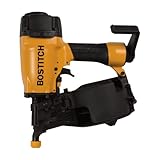 The Bostitch N66C-1, 1-1/4-inch to 2 ½ inch Coil Siding Nailer is powerful and is often drives plastic inserted and wire weld coil nails.
The Bostitch N66C-1, 1-1/4-inch to 2 ½ inch Coil Siding Nailer is powerful and is often drives plastic inserted and wire weld coil nails.
It is very reliable and can easily withstand most jobs you may have for it.
It offers a full list of essential design features making it one of the best choices all year round for professionals and home improvement enthusiasts.
- Drives 1¼-inch to 2-inch nails.
- Pressure: between 70 and 120 psi.
- Magazine: 100 caps and 350 nails.
Our In-Depth Review:
Aesthetically, this nail gun appears and feels like a premium product, with a glossy orange paint job and ergonomic handle, which feels sturdy to the touch.
It is important that it feels comfortable, as nailing jobs can and do take quite a bit of time. Its housing is made of aluminum, making it more high-end in its finish in comparison to similar products that are finished in plastic. This reduces weight to, a great point for those nailing marathons.
During use, it is precise and powerful. It works well with a whole host of siding materials, such as steels and softwoods. With its adjustable pressure of between 70 and 120 psi, this nailer ensures nails are driven into the correct depth while providing and inches to pounds ratio of 515/1. Various nail sizes are also acceptable to this nailer, as well as a whole raft of air compressors.
For anyone who has not used a nailer before, this nailer needs an air compressor. On its own, this tool will lack a power supply, meaning that you may require a nailer that is battery-powered (less powerful and rarer). An air compressor is a sound investment as it is used in a myriad of different purposes while being reliable and lasting a long time. This tool cannot work without one.
Its nozzle can be redirected so as not to blow exhaust fumes in your direction. This is a darn nifty safety feature that many users will appreciate. Additionally, potential damage to softer woods is mitigated by the soft foot.
It is important to note that this product is specifically a siding nailer, meaning it is primarily used in the addition of siding to your home or rehabilitate what is already present. It is not designed as an ‘all-rounder’ but rather as a siding nailer, not that it could not accomplish other tasks!
It can, but it was designed with a particular purpose in mind. Also, the trigger’s nature can only be switched manually, which may be a downside to some.
Pros
- No tool required to adjust the exhaust.
- Softwoods suffer no damage.
- Durable aluminum used in a lightweight design.
- Adjustable depth system.
Cons
- Deck construction problematic.
- Multiple bent nails and jams.
- Doesn’t nail in flush.
Conclusion:
The Bostitch N66C-1 1-1/4-inch to 2-1/2-inch Coil Siding Nailer is an ideal choice for nailing siders. It is reliable and affordable. It may suffer some problems with misfires and jamming but it has a smart design featuring some clever touches. Higher up the price range more power may be available to you but it is often a case of diminishing returns. Particularly for siding, this is a brilliant buy and it is highly recommended by professionals and DIYers alike.
7. Makita Af505n
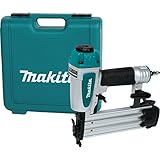 For those who are new to nailing, banging on nails with a hammer can quickly become a chore.
For those who are new to nailing, banging on nails with a hammer can quickly become a chore.
The effort required, along with the precision that is needed can tire even the most energetic amongst us. Also, it is quite likely that mistakes will be made, costing time and money to correct. Even the more experienced amongst us will find it quite cumbersome to nail manually on large projects.
Enter the Makita AF505N Brad Nail gun.
- Nail size: between 5/8” and 2”.
- Operational air pressure: between 60 and 115 psi.
- Source of power: air.
Our In-Depth Review:
There are many types of nail guns for an assorted number of specialized purposes, and a brad nail gun is an ideal choice for general use and beginners. Within the brad nail gun segment, there is quite a number to pick from, but by far the pick of the bunch is the Makita AF505N Brad Nailer.
- A look at its features bears out the notion of this nail gun being amongst the best brad nailers around. These include:
- An eloquent and slim nose design that makes it simpler to carry as well as making it easier to reach difficult to reach and confined spaces,
- Its tool-less nature that allows for the clearing out of jammed nails, therefore, increasing efficiency while reducing work time overall,
- A dial for depth adjustment makes this a far more accomplished finishing nailer through its tool-less nature
- Its rubber nose prevents any type of damage to materials being worked on
- The nose is expertly crafted to make sure of accuracy and precision
- Convenience is maximized due to its tool grip being adjustable to your tastes very lightweight design assures simplicity of use and maximum portability
- Its exhaust port is fully adjustable ensuring no interruptions and maximum convenience
- Nail magazine with a 100 nail load
- Makita is known for their innovative designs, with intuitive features. Features such as its special functionalities, stellar infrastructure, and high-tech nose design make this Brad Nailer the one to have.
The Makita AF505N brad nailer features a feature-rich nose that is designed to be narrow and rubber-tipped. This allows for difficult to reach area nailing as well as leaving the material scuff-free and undamaged. On top of all this, these nose design features allow for accurate and precise nailing, leaving projects looking well and professionally finished.
This tool features a way to unjam any nails that may have jammed while in use. The assembly, where all nails are lined, can easily be opened and the jamming nail removed or reset. Moreover, the setting for depth adjustment comes in handy often while nailing, as it makes uniform nail depth possible, making the job look attractive and professionally finished.
This unit’s tool grip is fully adjustable to 180 degrees, making you nail without interruption. Similarly, this nailer’s 360-degree adjustable exhaust opening allows for exhaust gases to be directed away from your face while working.
Pros will have a problem with this model as being tethered to a power source will limit mobility.
Pros
- Nose design is narrow for added precision.
- No-tool functionality.
- Adjustable exhaust port and tool grip.
- The tool grip is adjustable to 180 degrees.
- Mobile and light.
Cons
- Oil supply required.
- Reduced portability due to requiring cord to work.
- No mode for rapid fire.
Conclusion:
The Makita AF505N Brad Nail Gun, 2-inch is an affordable and efficient nailer. It is far ahead of its contemporaries, in both its feature set and reliability. It is a state of the art product that fuses an innovative nose design with a large number of appropriate features to make it one of the very best brad nailers out there.
8. Metabo HPT Nv45ab2
 The Metabo HPT NV45AB2 roofing nailer is a perennial best-selling roofing nailer, due to its lightweight (5.5lb) and is essential in any roofing project.
The Metabo HPT NV45AB2 roofing nailer is a perennial best-selling roofing nailer, due to its lightweight (5.5lb) and is essential in any roofing project.
It features a quick response and rapid driving with a firing mechanism reaching 3 nails a second!
This roofing nailer can fire most regular roofing nail sizes, between 7/8” to 1-3/4”. Its adjustment for depth drive will allow nails to be driven to any desired depth while operating within pressure ranges of between 70 and 120 PSI.
- Pneumatic power source.
- Coil loading type.
- 120 PSI maximum pressure when operating, 70 PSI minimum.
- 120 magazine capacity.
- 3/8 NPT inch air inlet size.
Our In-Depth Review:
This 1-3/4 inch coil roofing nailer from Metabo quickly nails down roofing materials. With its side-loading capabilities, this nailer can be reloaded easily and fast for additional productivity. Reliable operation is ensured by its pneumatic power feed and return even in harsh worksite conditions. No additional products are required to adjust for nail depth, providing the user with accurate and precise nailing in every instance.
The carbide-tipped push lever helps reduce degradation even after multiple usages. This nailer is easily portable, as it weighs only 5.5 pounds. Rubber pads ensure that jobs featuring angled surfaces are well and safely nailed due to lack of slippage, with rubber again making an appearance on the grip, ensuring a firm hold when nailing.
Ideal for DIY-ers and professional contractors, the Hitachi/Metabo HPT NV45AB2 Roofing Nailer is reliable, efficient and effective while getting the job done, whatever the weather. It’s accurate and can be relied upon during long and rough projects.
It’s operable with a single hand, well-balanced and lightweight, perfect for nailing roofing materials. It is straight-forward and laid out as such, with its constituent parts all within easy reach, perfect for a would-be user on their first try.
Whatever the weather, cold or hot, Hitachi/Metabo can deal with it. This nailer is designed to operate under the harshest of climatic conditions, be it in the rain, snow or hot sun. Some nailers stop operating and freeze up when temperatures dip, but not this nailer.
Tested in freezing conditions, it is your nailing partner, in any kind of weather. The secret to this roofing nailer is its system of feeding nails, powered by air. It automatically eliminates moisture, residue, and dirt from the nailer.
Its magazine can accept one hundred and twenty coiled nails, with sizes ranging from 7/8” to 1-3/4”, and shank diameters of 0.120. This adds to this roofing nailer’s appeal, its ability to drive smaller-sized nails. Its nail magazine is very easily reloadable, with it being simple to close after opening and reloading. It is a straightforward process, one that can be mastered I no time at all.
Pros
- Can accommodate smaller 7/8” nails.
- Easy and fast reload.
- Lightweight tool.
- Mode for quick-firing.
- Weatherproof.
Cons
- Expensive.
- Can misfire following extensive use.
Conclusion:
The Metabo Pneumatic Coil Roofing Nailer (NV45AB2) Wire Collation uses a magazine that is loaded on its side, a depth drive that is tool-less and wire collation to offer a nailer that is efficient and effective for all your roofing requirements. This lightweight, quick driving nailer can operate under inhospitable conditions due to its pneumatic return and power feed. It is designed to be used long-term, in comfort, and features a push lever that is carbide tipped and a grip that is rubberized for additional comfort.
9. NuMax S2-118G2
 The NuMax S2-118G2 Pneumatic 2-in-1 18 Gauge 2 Inch Brad Nailer and Stapler can be used in several applications. These include:
The NuMax S2-118G2 Pneumatic 2-in-1 18 Gauge 2 Inch Brad Nailer and Stapler can be used in several applications. These include:
- Crafts and hobbies.
- Assembly of picture frames.
- Window casing.
- Cabinet backing.
- Cabinetry.
- Exterior and interior trim and finish work.
This 2-in-1 stapler and brad nailer features a body that is ergonomically engineered which results in a tool that is lightweight and ideal for long periods of use.
Additionally, its grip handle is comfortable, which reduces fatigue, at the same time increasing accuracy and control of fastener location.
Its No-Mar safety tip aids in the prevention of work surface damage, while a handy reload indicator allows the user to see when fasteners are running low. Significantly, its exhaust is adjustable to 360 degrees directing air away from the user’s face, as well as debris.
- 60 to 110 PSI operating pressure.
- 18 GA fastener gauge.
- ¼ inch fastener crown.
- 100 piece magazine capacity.
Our In-Depth Review:
The NuMax S2-118G2 Pneumatic 2-in-1 18 gauge 2-inch stapler and brad nailer serves 2 different functions within the same tool, which makes it convenient and worthy of your hard-earned investment. This tool’s design is lightweight, which it owes to its design and manufacturing material: die-cast aluminum.
It features an exhaust that is adjustable which directs fumes towards anywhere but your face, making it a safe option. For those that have been using a hand stapler and a hammer, this is the perfect tool with which to upgrade. Its speedy and precise effectiveness is precisely what you need.
This tool’s biggest selling point is its versatility, the fact that it can drive both 18-gauge staples and nails. I addition, further selling points are it coming with a dust cap, reducing the spread of contaminants from your immediate vicinity. Also included is lubricating oil, which aids in better performance of the tool.
This combination stapler and nail gun is powered by air and is compatible 18 gauge glue-collated ¼-inch narrow crown staples between ½-inch to 1-5/8 inch and 18 gauge brad nails between 3/8-inch and 2 inches. The aluminum body, which is ergonomically engineered is constructed durably, the results of which are a lightweight product that can be used over a long time.
Fatigue is reduced by its comfortable grip while accuracy and control both go up when placing fasteners. This combination finishing tool also features a no-mar safety tip that prevents work surface damage, an exhaust that is adjustable to 360 degrees that directs air elsewhere and not towards the user’s face and a reload indicator that conveniently shows you when fasteners are running low.
Pros
- Affordable.
- Portable and lightweight.
- Depth control is adjustable for varying applications.
- Untimely versatile.
Cons
- May leave behind imprint marks on a work surface.
Conclusion:
The NuMax S2-118G2 Pneumatic 2-in-1 18 gauge 2-Inch Stapler and Brad Nailer is an inspired choice for exterior and interior trim and finish work, crafts, hobbies, assembly of picture frames, window casings, cabinet backing, and cabinetry. It is a rugged and affordable stapler and nailer that increases productivity for home improvement DIY-ers tacking repair projects, and professional contractors as well. This product includes adjustment tools and air tool oil.
10. Ryobi Zrp320
 The Ryobi Brad nail gun is known as one of the leading cordless brad nailers on the market because of its price-friendliness and the excellent service that it renders. Its affordability does not take away from its superior service and quality, and as such, for those on a budget, this is the brad nailer for you.
The Ryobi Brad nail gun is known as one of the leading cordless brad nailers on the market because of its price-friendliness and the excellent service that it renders. Its affordability does not take away from its superior service and quality, and as such, for those on a budget, this is the brad nailer for you.
One drawback that can be pointed out is the fact that its charger and battery are sold separately.
It sports great features, chief among them its dry fire lockout mechanism. This feature allows nailing to continue without the fear of fire being produced. This lengthens the life of the product while keeping the user safe while operating it.
Its drive can be set to either contact or sequential actuation, comes with a nail reloading LED indicator and a fantastic battery life.
- Sequential/contact actuation firing mode.
- Brad nails fastener type.
- 18 fastener gauge.
- Adhesive fastener collation.
- Li-ion battery type.
Our In-Depth Review:
This cordless, battery-powered nailer drives 18-gauge wire brads, which are purchased held together in long strips. These nails are used in baseboards, crown, trim, finish work as well as other lighter materials. This is not a structural nail gun. Overall, this nailer is an admirable performer, deploys plenty of nailing power for trim as well as other carpentry finishing tasks.
Magazine capacity is 105 brads fired at the rate of one per second, powered by an 18-volt lithium-ion battery by Ryobi’s ONE+. A useful feature is a Dry-Fire Lockout that prevents the last several nails from being fired so as to extend the nailer’s life, making the magazine capacity more like 100 nails.
Brads 5/8 inches to 2 inches long are fired by this nailer, which comes delivered in 2 strips of 1-1/4 inch brads in length, perfect brad length for trim installation. Replacement brads can be purchased from third-party vendors, as Ryobi does not supply them.
Several key features of the Ryobi ZRP320 ONE+ 18volt Cordless Lithium-Ion 2 Inch Brad Nailer are:
- Drive depth adjustment: nails can be driven shallower or deeper with the turn of a wheel.
- Dial for air pressure: internal air pressure is controlled by a dial, giving less or greater force.
- Mode selector: a toggle between Contact and Sequential Actuation is easily identifiable and simple to use.
This nailer can drive sixty nails a minute, which is one a second! This is made possible through the feature Contact actuation. Practically, the trigger is depressed continually as the nailer is moved along the job surface. Once contact is made between the plastic No-Mar Pad and the job surface, the nailer drives nails automatically.
This leads to faster nailing, although less precisely. On the other hand, Sequential Actuation means once the nailer is placed, the trigger is pulled and the process is repeated.
The downside to the fast nailing mechanism is the frequent jamming to which it subjects the machine. This can be annoying especially when you’re working with tight timelines. Another disappointment buyers have expressed is that they have to spend on a battery pack and charger after spending on the nailer. A good number of other battery-powered nailers come with these as standard.
Pros
- A dry fire lockout mechanism.
- The battery is high-quality.
- LED indicator.
- Price-friendly.
Cons
- Jams frequently.
- Battery and charger sold separately.
Conclusion:
The 18V One Plus system brings forth cordless roof nailing to the next generation. Featuring AirStrike tech, this eighteen gauge brad nailer takes away the requirement for pricey gas cartridges, bulky hoses, and noisy compressors. This translates to easier maneuvering and faster setup during projects.
The 18V One Plus 18GA Cordless Brad Nailer comes bare, allowing users to build a ONE Plus collection, using the same chargers and batteries. Besides jams and the required extra investment in a battery pack, it is a worthy buy for the avid DIYer.
Nail Gun – Buyers Guide
What is a nail gun?
 A nail gun is a tool made to ease the process of driving in nails when joining two or more elements. It is made to save you the effort of hammering nails in.
A nail gun is a tool made to ease the process of driving in nails when joining two or more elements. It is made to save you the effort of hammering nails in.
These tools work using various mechanisms; there are those that work using an air compressor, others powered by flammable gases and others by an explosive charge.
Regardless of the mechanism they use, these implements eliminate the effort and inaccuracy of hammering. They are much more efficient too- driving in hundreds of nails a minute.
Who needs a nail gun?
Professional contractors whose earnings depend on how many projects they can complete will find a nail gun very useful. It will help them complete their woodwork earlier than they could have to rely on a hammer.
Heavy-duty nail guns will enable them to handle more demanding tasks like roofing and flooring without too much strain. Decorators and carpenters will find nail guns useful for driving in the smaller nails with no head that is used to attach moldings or fabrics to boards.
You don’t have to be a pro to invest in a nail gun; there are light nail guns for small DIY projects. Palm nailers are easy to handle and are available in electric and cordless forms. Such nailers are not too expensive yet they’re highly effective. Some are designed to be easy enough for beginners to get the hang of using.
How does a nail gun work?
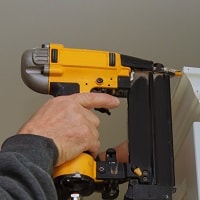 Nail guns may be powered by different mechanisms but the end game is the same; to drive a nail through a surface with minimal physical effort. Pneumatic nailers achieve this aim by using compressed air to create the force required to push a sliding piston to drive in the nail.
Nail guns may be powered by different mechanisms but the end game is the same; to drive a nail through a surface with minimal physical effort. Pneumatic nailers achieve this aim by using compressed air to create the force required to push a sliding piston to drive in the nail.
Combustion nailers also have a sliding piston, which is forced to move by a pressure imbalance. But in combustion nailers, the pressure imbalance is created by burning the gas in a combustion chamber.
An electric nail guns, a motor powered by electricity pushes a coil spring and releases it with a huge amount of force. While electric nail guns get this power directly from a power source in the wall, battery-powered nailers have this force stored in batteries.
Pneumatic nail guns vs cordless nailers
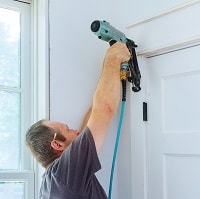 The above question really depends on what you want to do with the nailer. If you are a professional looking for a high-performance tool to see you through many jobs in a short time span, the pneumatic nailer is your best bet. You will have to buy an air compressor that matches the PSIs and volume of your nailer, though. And this may not auger very well for mobility.
The above question really depends on what you want to do with the nailer. If you are a professional looking for a high-performance tool to see you through many jobs in a short time span, the pneumatic nailer is your best bet. You will have to buy an air compressor that matches the PSIs and volume of your nailer, though. And this may not auger very well for mobility.
If your task entails you moving around a bit and doesn’t require too much power, the cordless nailer is a better idea. From its name you can tell that it doesn’t need to be connected to an external power source- be it a compressor or an electric source. For the battery-powered option, you only need to ensure its battery pack has enough juice to complete the task at hand.
It doesn’t require the sometimes tricky procedure of connecting your compressor to the nailer using an air hose before getting started. You just slide in the battery pack and you’re good to go. Cordless nailers tend to be compact and easy to handle, making them the perfect tool for those DIYers just getting started.
But what happens when you want the power of a pneumatic nailer fused with the mobility of a compact nail gun? This option is available in the form of a gas-powered cordless nailer. It doesn’t have the extra bulk of an air compressor and hose, yet it delivers a solid performance that will please pro contractors.
How to choose nails for your nailer
 When going out to get nails, you need to bear in mind some considerations to ensure you get value for your money. You don’t want to splash out on nails only to find they can’t hold the items in question together. If the project in question requires brad nails, go by this general rule of thumb; the length of the nailer should be thrice the thickness of the surface you’re nailing through.
When going out to get nails, you need to bear in mind some considerations to ensure you get value for your money. You don’t want to splash out on nails only to find they can’t hold the items in question together. If the project in question requires brad nails, go by this general rule of thumb; the length of the nailer should be thrice the thickness of the surface you’re nailing through.
Another differentiating factor between brad nails is the material they’re made of. Some are made of stainless steel while others are of galvanized steel. The former tend to last longer than the latter.
Ultimately, the kind of nail you buy will be determined by what you want you to want to nail. There are different kinds of nails for different tasks; there are larger nails with round heads, which are ideal for roofing. These are required to be stainless steel as they will be exposed to the elements and be able to resist rust.
If you’re driving nails through concrete, they need to be hardened to be able to pierce through. There are also nails used specifically with drywall while duplex nails are used for temporary jobs and thus have two heads to ease removal.
The type of task you have will determine the type of nail you need, and this, in turn, will determine the nailer you should get.
Nailer firing methods
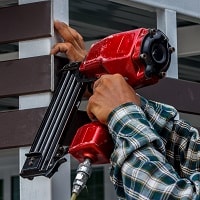 Knowing the kind of firing a nailer is capable of will determine if it will be a worthy ally for your construction/renovation mission. There are essentially two ways you can fire a nail gun: contact or bump firing and sequential firing.
Knowing the kind of firing a nailer is capable of will determine if it will be a worthy ally for your construction/renovation mission. There are essentially two ways you can fire a nail gun: contact or bump firing and sequential firing.
Contact firing
Think of the rapid-fire bursts of an automatic weapon and you’ll have a clear idea of how to bump firing looks. In this mode, a nailer will fire nails continuously into the surface as long as you keep the trigger depressed. As you can imagine, this type of firing can speed things up, but you’re advised to be cautious.
You will have less control of the gun when bump firing, thus the chances of accidental firing is higher. If you’re not careful you may have to conceal the marks of removed nails. Not to mention the increased risk of harming yourself.
Sequential firing
This is basically how you would operate with a hammer- driving in one nail at a time. It is a safer way to use a nailer as the safety tip is activated for the firing of each nail. You have to release the trigger after firing in every nail, giving you more control over the outcome of nailing. The downside is that you will slow down your workflow.
Single-sequential firing
There is a variation of sequential firing that requires you to work the safety tip when firing the first nail, but allows you to bump fire after that. After firing in the first nail, you can keep the safety tip activated by pressing it against the surface while releasing other nails by releasing the trigger.
Types of nailers
Besides their power source, nailers can also be classified by the kind of nailing they are made to do. They can also be classified by the kind of nails they fire.
These are meant to fire the staples that fasten carpets to floors, among other applications where the fabric needs to be attached to a wooden surface. They are therefore also used a lot in upholstery.
These nailers are used to tap in lightweight 23-gauge nails that are usually not meant to hold permanently. You can mistake these nails for pins, hence the name. Common applications are in carpentry finishing where pieces to be glued together need temporary holding.
Staying in the lightweight division, here is a nailer that you can comfortably operate with one hand. It is small enough to fit in your palm and comes with a strap that wraps around your wrist to keep it in place during operation.
They are designed to handle some of the work of heavier-duty nailers, and thus are usable with regular size nails, but their lightness allows you to work with them for longer. Some can drive even six-inch nails, meaning they can be useful for roofing projects.
Their size makes them great for precision nailing, as well as working in tight spots.
These are designed for use with brad nails, which are popular for finishing. They can comfortably fire in 18-gauge nails but they can also be used with the 15 to 16-gauge nails that are used on baseboards and trim work. However, there are finish nailers, specifically designed for such tasks. These are also great for various carpentry assignments.
Before we go into the heavyweights, we can glance through the siding nailer. This gadget is designed to join thinner boards using between 1¼-inch and 2½-inch nails.
As the name suggests, these nailers are a roofer’s best friend. They are required to push nails through the wood at high speeds; hence the popularity of the pneumatic version of this category of the nailer. There are solenoid and spring-loaded variations of roofing nailers but contractors will prefer the efficiency of pneumatic nailers.
This tool is built for heavier jobs- it can comfortably join two by four boards, making it the right tool for working on your deck, wood siding, and fences. They are versatile- able to hold both sequential and contact firing tips, and they allow users to adjust the depth of drive without any tools.
Designed unlike the other categories of nailers, flooring nailers, as the name implies, are primarily used to join floorboards. Laying tongue-and-groove boards is a breeze with this beauty by your side, particularly if you’re using the pneumatic version.
Things to consider before buying a nail gun
From what you’ve read so far, you can no doubt see that nail guns come in many different flavors. In each category of nailer we’ve mentioned, there are several brands and models to choose from. Here are some tips you can use to help narrow down the search and get the right tool.
Usage
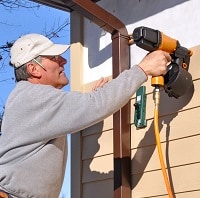 This will be the most important factor to consider. The kind of task you wish to accomplish will determine the appropriate nailer for it. If you are a contractor with a series of roofing or renovation jobs in the pipeline, you need a heavy-duty nailer that can work for several hours without giving you problems. A combustion nailer may not ideal as you would need several fuel cartridges to get a job done.
This will be the most important factor to consider. The kind of task you wish to accomplish will determine the appropriate nailer for it. If you are a contractor with a series of roofing or renovation jobs in the pipeline, you need a heavy-duty nailer that can work for several hours without giving you problems. A combustion nailer may not ideal as you would need several fuel cartridges to get a job done.
You also need a tool that is comfortable to use for long periods of time. You will also need a nailer that can switch between bump and sequential nailing to allow you to accomplish tasks in a good time. Most professionals will have more than one nail gun for different purposes.
DIYers and hobbyists won’t see the need to invest in more than one nailer. For this reason, they will prefer a versatile tool that they can use across different tasks.
Type of nails
Different types of nailers work with different types and sizes of nails. The kind of project you’re undertaking will determine the kind of nails you need. Framing, for instance, requires nails at least 3½ inches long to join 2×4 boards. For this, your go-to tool will be a framing nailer, which are the most heavy-duty guns available.
If all you want to do is some light trim work with easily concealable headless pins, a pin nailer is what you’ll need. However, you need to know the length of pins you’ll need as pin nailers also come in a range of sizes.
Brad nailers are built specifically for brad nails, 18 to 23-gauge nails made for more delicate jobs.
Ease of use
While some nail guns render themselves to easy usage for beginners, others require some getting used to. If you’re only just getting your DIY feet wet, you’re better off going with a compact battery-operated nailer. Besides being lighter and easier to handle, they don’t have pieces that need to be connected, unlike pneumatic nail guns.
Also, note that adjusting the depth of drive in some nailer models is more difficult than in others.
Cost
When it comes to cost, we mean looking for a nailer that can help you accomplish the kind of task you have, without overshooting your budget. Every class of nailer has a low and a high-end version as well as several models in between. Try to find the model that will give you the best value for money considering not just the task at hand, but projects you might undertake in the future.
Added extras
Besides the power to drive in nails, what more do you get for your investment in the nail gun? We may call it an extra but directional exhaust is quite an important feature. Some fuel-driven nail guns discharge the exhaust fumes from combustion right in the faces of users. Some nailers come with an LED light to light up dark nooks you’re working on while other models come with a neat carrying case.
Power sources
Let’s delve deeper into the different kinds of power sources nail guns can work with.
Pneumatic
This breed of nailers is traditionally the heavy hitters as they offered the most power. Air from a compressor is used to drive nails in pneumatic nailers and the amount of power delivered depends on the amount of pressure it offers, measured in pounds per square inch (PSI). While you get a higher amount of power with pneumatic nailers, the fact that you will have to connect a compressor and hose limits its mobility. The noise can also put off beginner DIYers.
Combustion
Also known as fuel or gas-powered nailers, combustion nail guns are powered by combusting gasoline in a chamber. The explosive force from the combustion is what forces the nail into the surface. The spark that ignites the gas is provided by a battery on the unit while the fuel itself is contained in a disposable fuel cell. Such nail guns offer a good amount of power along with a good amount of mobility as they are cordless. The only downside is that you might need to carry many fuel cartridges if you’re working on a big project.
Battery-powered

These nailers tend to offer substantially less power than pneumatic nailers but are generally lighter and easier to handle. Driving power is derived from a motor that compresses a coil and release it suddenly with plenty of force. This force is enough to pierce nails through boards of varying thickness.
It has to be said that more and more powerful battery nailers are being introduced to the market. Today you can find heavy-duty models with batteries that can handle about the same workload as their pneumatic rivals. Not only is their capacity increasing to hold a charge for longer, but they are also being made to juice up in less time.
Solenoid
These generate an electromagnetic field by running an electric current through a wire. This electromagnetic force repels a magnetic piston, which slides down a blade to provide the force required to push a nail on the tip of the nail gun.
As it dispatches the nail, the piston also hits a switch that changes the direction of the flow of the current, which causes the solenoid to pull it back into position for the next nail. Like battery-powered nail guns, solenoid nailers are a bit limited in the amount of nail-driving power they offer.
Nail gun maintenance
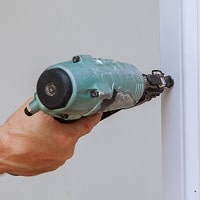 Proper nail gun maintenance not only ensures that it works as it should for a long time, but it also enhances your safety as a user while operating it. Every nail gun will come with a detailed manual, including some steps to follow regarding its maintenance. Read and follow these steps carefully. You can add the below general tips to what the manufacturer recommends. Remember to ensure the nail gun is off and disconnected from its power source before you begin.
Proper nail gun maintenance not only ensures that it works as it should for a long time, but it also enhances your safety as a user while operating it. Every nail gun will come with a detailed manual, including some steps to follow regarding its maintenance. Read and follow these steps carefully. You can add the below general tips to what the manufacturer recommends. Remember to ensure the nail gun is off and disconnected from its power source before you begin.
- Inspect the nail gun regularly to see if any screws or bolts are loose. Tighten them where necessary. It is recommended you conduct this inspection at least once a month.
- Clean out the feed system with a blower to get rid of any debris from a previous job.
- Look for any signs of damage to the unit and desist from using the gun if you notice significant damage.
- Apply oil to moving parts frequently, and if you will be working with the gun throughout the day, oil it at intervals as you work. Note that the air fitting for pneumatic nail guns needs to be
- lubricated on a daily basis. You can use your finger to oil the O rings in the fitting.
- Cordless nailer battery packs need to be checked every now and then to ensure they’re not past their expiry date.
Nail gun safety
Thousands of nail gun users are hospitalized every year with serious injuries. Most of these cases are pros who get injured in their line of work. Even with the most advanced nail guns, the risk of injury is never too far. Here are a few precautions you can take to ensure you don’t become a victim of your nail gun.
- Read the manufacturer’s instructions carefully before beginning usage.
- Being fully aware of the capacity of the tool you’re using and the fact that it can harm you. Don’t presume.
- If, during your regular inspection of the nail gun, you find any defects, repair them before using it.
- Wear safety gear such as safety goggles and earplugs.
- Whenever you can, use sequential nailing instead of bump nailing.
- Have first aid equipment within easy reach in your work environment.

